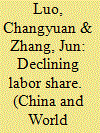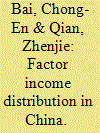|
|
|
Sort Order |
|
|
|
Items / Page
|
|
|
|
|
|
|
| Srl | Item |
| 1 |
ID:
099907


|
|
|
|
|
| Publication |
2010.
|
| Summary/Abstract |
This paper explores why labor share in China has declined since the middle of the 1990s. Existing literature usually ascribes the labor share decline in developed countries to biased technological progress. However, our investigation shows that China's case is different. Using a simultaneous equation model estimated with three-stage least squares, we find that FDI, levels of economic development and privatization have negative effects on the labor share. The negative influence of FDI on labor share results from regional competition for FDI, which weakens labor forces' bargaining power. A U-shaped relationship exists between labor share and the level of economic development, and China is now on the declining part of the curve. The negative effects of privatization on the labor share stem from the elimination of the so-called "wage costs eroding profit" situation and the positive supply shock on the labor market.
|
|
|
|
|
|
|
|
|
|
|
|
|
|
|
|
| 2 |
ID:
101165


|
|
|
|
|
| Publication |
2010.
|
| Summary/Abstract |
This paper investigates changes in aggregate labor share in China during 1978 and 2007 with a particular focus on the 1995-2007 period during which official statistics report a drop of 12.45 percentage points in labor's share of national income (labor share). Our main findings are: (1) The reported fall in aggregate labor share is overstated. According to the official statistics released by the NBS (2007a), the labor share fell 5.25 percentage points from 2003 to 2004. However this dramatic decline, 42.16% of the total reported decline of the labor share from 1995 to 2007, is completely due to the changes in the way NBS break down the operating surplus state-owned and collective-owned farms and the mixed income of the owners of individual economy; (2) For the last three decades, two main forces have been driving shifts in the aggregate labor share: (i) structural transformation between the agriculture and non-agriculture sectors and (ii) shifts in the labor share within the industry sector; (3) From 1995 to 2003, these two effects are both negative and together drive down aggregate labor share by 5.48 percentage points. The structural change explains 61.31% of the decline and the remaining 38.69% of the decline is due to the changes in the labor share within sectors, primarily in the industry sector; (4) Labor share in agriculture is lower than labor share in services. Therefore, when the service sector grows relative to the agriculture sector in the economy, the aggregate labor share of income declines; and (5) Restructuring of the SOEs and expanded monopoly power are the main reasons for the decline of labor share within industry after 1998. Relative price shifts, the factor input ratio, and biased technological progress are all insignificant forces for this decline because the substitution between factors in the industry sector is nearly unit elastic.
|
|
|
|
|
|
|
|
|
|
|
|
|
|
|
|
| 3 |
ID:
124562


|
|
|
|
|
| Publication |
2013.
|
| Summary/Abstract |
Despite the "growth miracle" of recent decades, labor's share, i.e., the share of total labor compensation in GDP, has decreased in China. Labor's share is an important indicator of the primary distribution of national income, and its fall has drawn significant attention from researchers and policymakers. As China's many regions have different development levels and economic structures, it is very likely that labor's share will differ across regions. Thus, it is important to examine the regional disparity of labor's share. In this paper, we develop a conceptual framework based on existing theories to identify the factors that influence labor's share. We, then, use Chinese provincial data from 1997 to 2007 to describe the regional differentials in labor's share and its evolution over the 10-year period and to explain regional disparity in labor's share. We take into consideration spatial correlations across regions and employ spatial cross-sectional and panel models in the empirical analysis. We found that industrial composition and ownership structure were the two key factors that influence labor's share. We also found that the average labor income was lower but labor's share was higher in western areas compared to eastern areas. The higher levels of labor's share in western provinces may be explained by a higher share of agricultural industries and state-owned enterprises, as agriculture and state-owned sectors tend to distribute more income to labor than to capital.
|
|
|
|
|
|
|
|
|
|
|
|
|
|
|
|
|
|
|
|
|